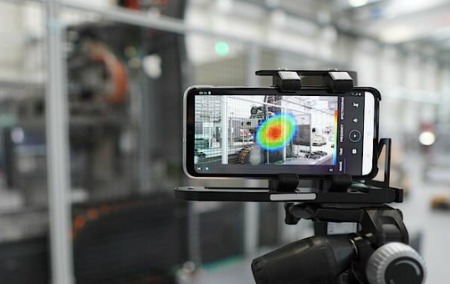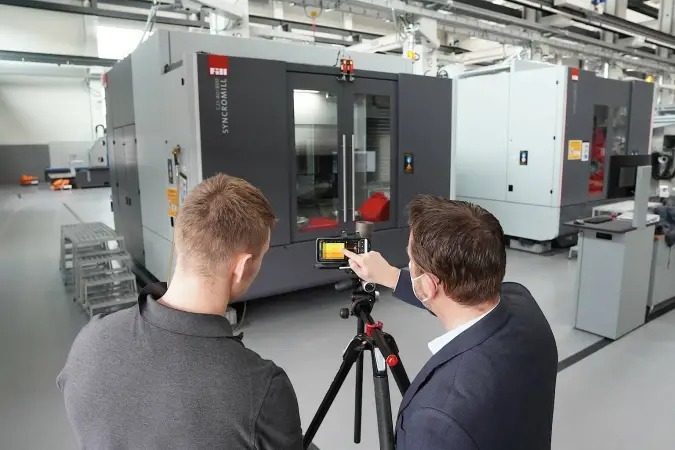The Seven Bel patented innovation of a moving sensor Sound Scanners is able to simulate up to 480 microphone positions on a circular area while using only five built-in microphones. Comparable acoustic cameras are normally equipped with about 100 microphones. This advantage has significant impact on the measurement quality. The unique mobility and handling and high-quality measurement results make the Seven Bel Sound Scanner P132 a high-performance measurement device that can be used and transported easily.
 The latest mobile app release from Seven Bel features numerous optimizations of existing functions. Acoustic images and audio data can now be analyzed side by side on one large screen. Tablet users can experience a higher level of comfort by manipulating the time and frequency domain while immediately inspecting the effect on the acoustic image. The acoustic image and the audio data section can be dynamically resized increasing further productivity and usability leaving more time for actual problem-solving.
The latest mobile app release from Seven Bel features numerous optimizations of existing functions. Acoustic images and audio data can now be analyzed side by side on one large screen. Tablet users can experience a higher level of comfort by manipulating the time and frequency domain while immediately inspecting the effect on the acoustic image. The acoustic image and the audio data section can be dynamically resized increasing further productivity and usability leaving more time for actual problem-solving.
Seven Bel’s acoustic camera allows machine builders to locate disturbing noises during development and on existing equipment making it easier to implement targeted measures to sustainably reduce noise levels.
A Sound Application Example
Machines that work with aluminium are in a world of their own. Their acoustics particularly. As an example, when profiles are made of aluminium, cavities in the profiles sometimes increase vibrations in a highly unique way. The sounds that are generated are clearly audible, but it is often very difficult to find their exact source.
Matthias Gamisch, Sales Manager for the Upper Austrian special machine manufacturer Fill, advised on such a case: During the acceptance test, the machine, which was designed for a well-known Austrian customer, made a noise that no one could identify. Quiet but clearly perceptible. However, due to the spatial conditions in the factory, this particular customer wanted maximum noise reduction.
 “In such cases”, explains Gamisch, “there is actually a standard solution: The entire machine is encased in sound insulation and the job’s done”. However, the insulation requires space which can be a problem in production halls where space is at a premium. However, for the machine delivered by Fill, there was another reason why insulation was not an option: One of the most important features of the machine is a window which provides a view inside, which was specially requested by the customer. If an insulating covering was used, the window would have had to be covered.”
“In such cases”, explains Gamisch, “there is actually a standard solution: The entire machine is encased in sound insulation and the job’s done”. However, the insulation requires space which can be a problem in production halls where space is at a premium. However, for the machine delivered by Fill, there was another reason why insulation was not an option: One of the most important features of the machine is a window which provides a view inside, which was specially requested by the customer. If an insulating covering was used, the window would have had to be covered.”
“In cases where this covering is not an option, there is, of course, a solution. However, it is more costly: You build components based on more or less justified suspicion, check whether they might cause the sound, reinstall them, check the next one until you find the fault. Or not. You can also try to assess the machine with a microphone, record the noise and hope that the issue is located where the noise is loudest. “Unfortunately that only works to a very limited extent”, explains Gamisch. “Because sound is very easily deflected and only rarely penetrates to the outside from the place where it is produced directly.”
The Camera Solution
Luckily, says Gamisch, when the sound problem occurred, he also knew of a third, relatively new option: The use of an acoustic camera. “We had casual contact with Seven Bel beforehand. Now was the time to try the sound scanner produced by Seven Bel in a real-life situation.”
The outcome, Gamisch recall, was a surprise several times over. Four different sound sources were identified in one afternoon. Above all: “Two of them we would have perhaps found without the camera, they were logical in the end. But the other two – I don’t think even the most experienced of our technicians would have thought of them.”
In any case, the time saved was significant. After around a week, during which the unwanted noises were removed through improved construction, the Seven Bel acoustic camera was used again and it was documented, also for the customer, that everything was now green, and the issue was deemed resolved after less than two weeks.
Using conventional methods, says Gamisch, it could have taken five times as long. “I can therefore imagine that acoustic cameras are already being used as a test tool for special orders requiring particularly quiet machines when the machine is being built.”
For more information: www.sevenbel.com
Tags: 3d vina, hiệu chuẩn, hiệu chuẩn thiết bị, máy đo 2d, máy đo 3d, máy đo cmm, Sound Scanner Makes Machinery Noise Visible, sửa máy đo 2d, sửa máy đo 3d, sửa máy đo cmm
